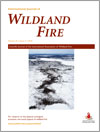This study demonstrates that fire science funded by the Joint Fire Science Program has been used nationally by fire and fuels managers to inform fire and fuels management decisions. This study also highlights factors that have commonly acted as barriers to (lack of manager awareness) and facilitators of (manager and scientist interactions) fire science application.

International Journal of Wildland Fire
Volume 25 Number 5 2016
WF15121What drives forest fire in Fujian, China? Evidence from logistic regression and Random Forests
Two different models were applied to identify the main factors influencing forest fire occurrence in Fujian, China. Climate, elevation, railway infrastructure and GDP were found to be important for local forest fire ignition. We also mapped the likelihood of fire occurrence in Fujian based on model results.
WF15149Fighting fire in the heat of the day: an analysis of operational and environmental conditions of use for large airtankers in United States fire suppression
Large airtanker drop data from the United States federal fleet from 2010 to 2012 are intersected with geospatial data to provide a post hoc characterisation of the operational and environmental conditions of use at the national scale.
WF14074Toward an integrated system for fire, smoke and air quality simulations
This study presents and tests an integrated wildfire smoke prediction system formed by coupling WRF-Sfire, a weather research forecast system plus surface fire behaviour model, with the chemical transport model WRF-Chem. The coupled WRF-Sfire-Chem aims to predict pyro-plume development, and smoke dispersion and its air quality impacts, by comprehensively modelling fire spread, heat release during flaming combustion, fire emissions and fire plume rise, as well as downwind smoke dispersion and associated chemistry.
WF14078Structure-level fuel load assessment in the wildland–urban interface: a fusion of airborne laser scanning and spectral remote-sensing methodologies
We used remote sensing data and analysis techniques to characterise fuel hazard in the wildland–urban interface at the resolution of individual structures. Our results indicate that this method can produce consistent estimates of canopy fuel loading across landscapes that can be associated with individual structures or parcels. The application of the work here could inform both strategic fire management decisions and broader, policy-level analysis.
WF14085Data assimilation of dead fuel moisture observations from remote automated weather stations
When dead wood in a forest is dry, wildland fires spread faster. We develop mathematical and statistical methods to provide fuel moisture maps from weather conditions and hourly moisture measurements from remote automated weather stations. These can be used to model fire spread or to estimate fire risk.
WF15114A laboratory-based quantification of the effect of live fuel moisture content on fire spread rate
The elusive effect of fuel moisture content on fire spread rate in live fuel beds was assessed from experimental laboratory data. A significant, albeit small, effect was found for typical live fuel moisture contents (>50%).
WF15156Seasonal relationships between foliar moisture content, heat content and biochemistry of lodgepole line and big sagebrush foliage
This paper measures seasonal increase in heat content and coinciding decrease in live fuel moisture content. Major driving biochemical components are crude fat and non-structural carbohydrates.
WF15135Dryness in a Mediterranean-type climate – implications for wildfire burnt area: a case study from Mount Carmel, Israel
Wildfires are frequent on Mount Carmel, a typical Mediterranean ecosystem characterised by dry summers. The burnt area of major wildfires is related to the number of days since rain on the day of ignition. Analysis of time series of dryness indicates an elongation in recent decades.
WF15147Wildfires in the eastern Mediterranean as a result of lightning activity – a change in the conventional knowledge
No records exist in the scientific literature about lightning fires in the eastern Mediterranean. In October 2014, a thunderstorm developed rapidly. Simultaneously, six wildfires were reported from different locations in northern Israel. This is the first case recorded in recent history of lightning wildfires in the region.
WF15170Using Landsat imagery to backcast fire and post-fire residuals in the Boreal Shield of Saskatchewan: implications for woodland caribou management
Designation of critical habitat for woodland caribou across Canada is underpinned by a total disturbance model that incorporates the combined extent of natural and anthropogenic disturbance. This paper identifies management and planning issues associated with overestimating burned areas by using fire mapping that doesn’t include post-fire residuals and water bodies.
WF15138Prescribed burning as a conservation tool for management of habitat for threatened species: the quokka, Setonix brachyurus, in the southern forests of Western Australia
The use of fire for quokka conservation was investigated. Retention of vertical vegetation structure and multiple unburnt patches were important for recolonisation of burnt habitat. These habitat outcomes from prescribed burning can be guided by surface moisture, soil dryness and fire rates of spread. Explicit ecological criteria are presented.



